导电金属有机框架材料在电催化中的成就,挑战和机遇
2021-07-10高增强王聪勇李俊俊朱亚廷张志成胡文平
高增强,王聪勇,李俊俊,朱亚廷,张志成,*,胡文平,2,*
1 天津市分子光电科学重点实验室,天津大学理学院化学系,天津化学化工协同创新中心,天津 300072
2 天津大学-新加坡国立大学福州联合学院,天津大学福州国际校区,滨海新城,福州 350207
3 化学系,理学院,新加坡国立大学,新加坡 117543
1 Introduction
Metal-organic frameworks (MOFs), as hybrid crystalline reticular materials composed of organic linkers and metalcontaining nodes, have drawn tremendous attention from researchers because of their captivating and unique advantages like outstanding surface areas, tunable porosity, and framework topologies1–5. The combination of these compelling features with well-defined ordered structures makes MOFs promising candidates for a wide variety of applications, such as molecular separations, energy storage and conversion, sensors, magnets,catalysis, biomedicine, and so on6–17. However, the electronic properties and applications of MOFs have attracted relatively less interest as the majority of MOFs are insulators with inherently weak conductivity (< 10−10S·cm−1)18,19. With the emergence of novel designing and synthetic strategies,considerable research interests have been focused on fabricating conductive MOFs and broadening their electrical applications20–24.
Until recent years, numerous two dimensional (2D) and three dimensional (3D) MOFs have been reported to be electrically conductive25, showing great potential in diverse electricalrelated applications, such as electrocatalysis26–30, batteries31,32,supercapacitors33–35, chemiresistive sensors36–39, field-effect transistors (FET)40–43, organic spin valves44, and other electronics or spintronics45–47. Among these applications, the utilization of conductive MOFs as electrocatalysts for electrochemical energy conversion has received special attention due to their favorable characteristics: (i) good electrical conductivity is beneficial for rapid charge carrier transfer; (ii)high specific surface areas and greatly exposed active sites are capable of enhancing the catalytic efficiency; (iii) well-defined structure and highly ordered porosity can facilitate the incorporation of metal sites and additional catalytic sites acting as hosts; (iv) tunable size, morphology, and structure with accessibly abundant active sites. These compelling features make the conductive MOFs extremely attractive for electrocatalytic reactions, including CO2reduction reaction(CO2RR), oxygen evolution reaction (OER), hydrogen evolution reaction (HER), N2reduction reaction (NRR), and O2reduction reaction (ORR).
Electrocatalysis has been perceived as one of the cleanest and the most renewable strategies to mitigate environmental issues and energy shortage problems48–50. More recently, conductive MOFs have been widely investigated as catalysts for electrocatalytic application10,51. However, a focused review of the synthesis and electrocatalytic application of conductive MOFs is still lacking. Herein, we aim to summarize the recent progress of conductive MOFs with a particular emphasis on their synthetic strategies and electrocatalytic applications. Firstly, two kinds of synthetic approaches, including hydro/solvothermal synthesis and interface-assisted synthesis, are summarized to fabricate conductive MOFs. Secondly, the applications of conductive MOFs as electrocatalysts toward catalyzing energyconversion reactions (CO2RR, HER, OER, NRR, and ORR) are elaborated. Finally, the existing problems and perspectives are highlighted, promoting their further development in the field of electrocatalysis. It is envisioned that this review can offer guidance and inspiration to design and develop highly efficient conductive MOFs for electrocatalytic applications.
Conductivity can quantify the efficacy of charge transfer,involving carrier mobility and the carrier concentration. And band-like and hopping transport are the general mechanisms, the former relies on strong interactions and can form continuous energy bands. For the latter, due to the discretely localized charge carriers, there are high barriers between the networks.Considering that the complex factors in the transfer mechanisms,five broad approaches are proposed to achieve the conductivity for MOFs52. (i) Continuous coordination bonds within MOFs can form a system of delocalization, contributing to high charge mobilities and small band gaps (Fig. 1a). (ii) The organic and inorganic components endow a part of MOFs with metal-organic analogs of graphene, which can transport charge by extended conjugation (Fig. 1b). (iii) MOFs withπ–πinteractions of organic linkers can transfer charges through space (Fig. 1c). (iv)MOFs with obfuscated grain boundary resistances and unknown defect concentrations are hard to distinguish the transfer mechanism. Thus, the small spatial separation and the redoxactive components can improve charge transfer (Fig. 1d). (v) The presence of the porosity can post-synthetically introduce electroactive guests into MOFs to promote the conductivity (Fig.1e).
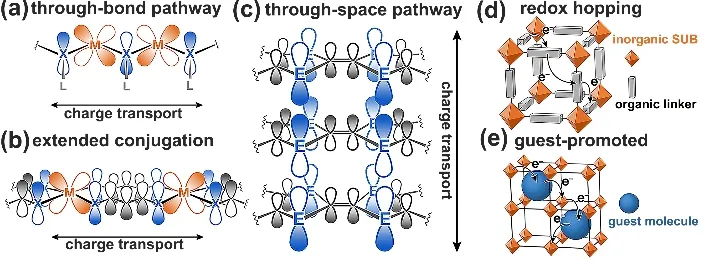
Fig. 1 (a) The through-bond pathway; (b) The extended conjugation pathway; (c) The through-space pathway; (d) A redox hopping mechanism; (e) A guest-promoted pathway.
2 Synthetic strategies of conductive MOFs
2.1 Hydro/solvothermal synthesis
The hydro/solvothermal synthesis is a conventional method that has been extensively employed to fabricate 2D or 3D MOFs with different morphologies (powders, single crystals, or films),especially for 2D conjugated conductive MOFs46. In this method, the reactants (monomers, solvents, and surfactant additives) are added into a sealed autoclave, where some factors,including the concentration of monomers, the types of solvents,reaction temperature, and time, have a great influence on the final products. Thanks to its simple operation, the hydro/solvothermal synthesis method is capable of preparing conductive MOFs in a high-yield, large scale, and low-cost way20.
For example, Dincăet al.applied 2,3,6,7,10,11-hexaaminotriphenylene (HITP) to react with Ni2+for forming 2D conductive MOFs of Ni3(HITP)2under solvothermal conditions53. The resultant Ni3(HITP)2bulk powders displayed a conductivity of only 2 S·cm−1, which could be attributed to the electrode contact resistances and the presence of grain boundaries. By utilizing different metal centers, the same group prepared another electrically conductive MOF of Cu3(HITP)2with a conductivity of 0.2 S·cm−1using a hydrothermal approach36. Powder X-ray diffraction (PXRD) measurement indicated that the as-obtained Cu3(HITP)2exhibited a 2D lattice with slipped-parallel stackings and hexagonal unit cells (a=b=2.23 nm andc= 0.66 nm). In addition to conductive MOFs based on the organic linkers of HITP, the tetrathiafulvalene (TTF)-based MOFs have also been widely prepared by the hydrothermal method54–56. For instance, three different TTFbased conductive MOFs with various topologies, including La4(HTTFTB)4, La(HTTFTB), and La4(TTFTB)3, have been constructed from the same TTFTB ligand and La3+under distinct solvothermal conditions56. It was found that their electrical conductivity was related to the stacking motifs, and the longer S…S contact distances would lead to the reduction of electrical conductivity. Additionally, the hydrothermal synthesis method has also been developed to synthesize conductive MOFs single crystals with exceptional electrical conductivities57,58. Recently,the 2D conductive MOFs (Ni3- and Cu3(HHTP)2) were obtained as single crystalsviathe solvothermal method58. Remarkably,single rods displayed a conductivity of 150 S·cm−1without distinct degradation over prolonged exposure to an ambient environment. These conductive MOF's single crystals afforded remarkable promise as the ideal platforms for electrical-related applications.
2.2 Interface-assisted synthesis
Although great achievements have been made regarding the synthesis of conductive MOFs, the majority of products are obtained as powders or single crystals which are difficult to be integrated into different devices. In contrast, conductive MOFs thin films provide more substantial opportunities for practical electronic applications and attract more attention from researchers owing to their good solution-based processability.Until now, a large number of conductive MOFs thin films have been prepared by interface-assisted synthesis methods including Langmuir-Blodgett (LB) methodology, air-liquid interfacial synthesis, and liquid-liquid interfacial synthesis.
The LB approach is proven to be effective for fabricating monolayer film on-air/liquid surfaces, where the surface pressure is used to promote the reaction of monomers in LB trough and the formed monolayer film can be readily transferred onto the suitable substrates. The utilization of LB methodology for the preparation of the MOFs monolayer began in 2010,Kitagawa group successfully constructed 2D MOFs of CoTCPPpy-Cu consisting of CoTCPP and pyridine at the surface of H2O59.Since then, the method of LB is extensively employed for fabricating various MOF films.
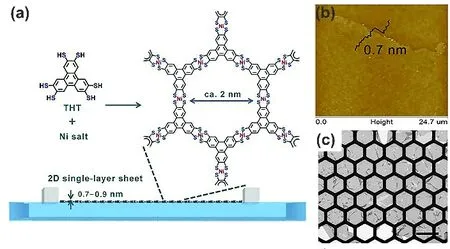
Fig. 2 (a) Schematic representation of the preparation of 2D single-layer MOFs using LB method; (b) AFM image of MOFs single layers showing thickness of ~0.7 nm; (c) TEM image of the single-layer MOFs on Cu grids.
Fenget al.fabricated large-area, free-standing, and single-layer 2D MOFs films from theπ-conjugated building block of 1,2,5,6,9,10-triphenylenehexathiol (THT) at an airwater interface through LB methodology (Fig. 2a)60. In detail,the THT monomers were firstly compressed into a densely single layer on the surface in a LB groove. With the injection of nickel salts solution into the aqueous solution, the coordination polymerization between the nickel and dithiolene unites occurred, leading to the formation of single-layer 2D MOFs with a thickness of ~0.7 nm and large lateral dimensions up to square millimeters (Fig. 2b,c).
In 2017, Xu and co-workers adopted an air-liquid interfacial approach to synthesize a conductive MOFs film of Ni3(HITP)2,exhibiting a smooth surface (average surface roughness of ~1.43 nm) (Fig. 3a–c)40. Such high-quality and flat MOF film was formed by the constant assembly of HITP and nickel ions on the water surface. The thickness of Ni3(HITP)2film could be well controlled by reaction time and a MOF film with a thickness of approximately 100 nm was afforded upon a 3-min reaction. The as-synthesized Ni3(HITP)2film was further used to construct a FET device as the active channel material, with a device geometry of bottom-gate top-contact. The fabricated FET displayed exceptional charge mobility of 48.6 cm2·V−1·s−1,which was comparable with other reported organic or inorganicbased FET. By varying metal centers, Lahiriet al.prepared a series of conjugated thin 2D MOF films by coordinating hexaiminobenzene (HAB) ligands with different metal ions(Cu2+, Ni2+, and Co2+) utilizing the air-liquid interfacial synthesis method42. However, poor crystallinity was observed in these MOF films, resulting in their poor charge transporting ability and insulating property.
The liquid-liquid interfacial reaction is regarded as another promising strategy to fabricate conductive MOFs films.In 2013, Nishiharaet al.proposed H2O/CH2Cl2interfacial reactions of fabricating conductive MOFs of Ni-BHT (BHT =benzenehexathiol) composed of nickel bis(dithiolene) units61. It was found that the resultant Ni-BHT films exhibited good crystallinity, a large lateral size of up to 100 μm, and a thickness of 1–2 μm. Subsequently, some other conductive MOFs,including PdDt62, NiAT63, and PtDT64, have also been prepared by the Nishihara group using the liquid-liquid interfacial approach, indicating the generality of this method in fabricating electrically conducting MOFs films.
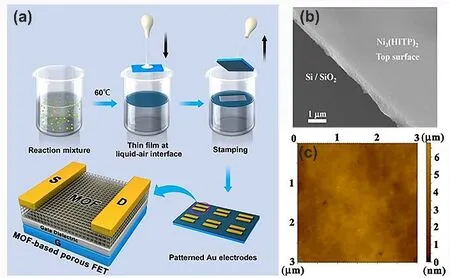
Fig. 3 (a) Schematic illustration for fabricating Ni3(HITP)2-based FETs; (b) SEM and (c) AFM images of Ni3(HITP)2 film.
Additionally, Zhu and co-workers utilized the dichloromethane (CH2Cl2)/water interface to fabricate highly crystalline MOFs films composed of copper bis(dithiolene)complex of Cu-BHT with an adjustable thickness (20–140 nm)(Fig. 4a–e)41. According to synchrotron radiation grazing incident X-ray diffraction (GIXRD) characterizations, the asformed Cu-BHT films were piled up by 2D plate-like sheets of[Cu3(C6S6)]n, which possessed a hexagonal lattice ofa=b=0.876 nm. By replacing metal centers of Cu with Ag, Zhuet al.also prepared highly crystalline Ag-BHT film through a coordination reaction between BHT and silver (I) nitrate at the toluene/H2O interface65. It was worth noting that the Ag-BHT film displayed remarkable conductivity (250 S·cm−1), showing great potential for electronic applications.
3 Conductive MOFs for electrocatalysis
Electrocatalysis is one of the particularly promising strategies to produce carbon-neutral fuels or industrial chemicals derived from petroleum, due to its mild soft reaction condition,controllable selectivity, and scalable application66. The strategy can efficiently decrease the emission of environmental pollutants by coupling with a renewable energy source, such as wind or solar energy67. Due to the components of MOF precisely modified at the molecular level, MOF has an intriguing potential in electrocatalysis68.
3.1 CO2 reduction reaction (CO2RR)
The electrochemical reduction of CO2to chemical products is an important route for meeting the energy demand, reducing the dependence on fossil fuel69–74. For electrochemical thermodynamics such as the formal potentials, the protoncoupled pathway, such as 4e−, 6e−, and 8e−processes, is more favorable75.

Fig. 4 (a) The digital photo of preparing Cu-BHT film at CH2Cl2/H2O; (b) Upside-up face (right) and upside-down (left)face of the as-fabricated film; (c, d) SEM images of the downside and upside surfaces (scale bar of 200 nm in (c), scale bar of 400 nm in (d),scale bar of 100 nm in the insets of (c) and (d)). (e) SEM image showing the cross-section of Cu-BHT film (scale bar: 400 nm).
Inspired by electrocatalytic degradation of carbon tetrachloride by Co-porphyrinic MOF76, Kubiak’s group applied electrophoretic deposition to construct a heterogeneous system by integrating redox-conductive Fe-porphyrins into thin MOF-525 films (Fig. 5a), which electrochemically covered catalytic sites (~1015sites·cm−2) in conductive surface77. The active Fe(0)-porphyrin species in Fe-based MOF films can produce 15.3 μmol·cm−2of CO and 14.9 μmol·cm−2of H2, whose current densities can reach 2.3 mA·cm−2for 0.5 h, and turnover number(TON) for CO in controlled potential electrolysis (CPE) was 272. With acidic proton donor (trifluoroethanol, TFE), the Fe(0)-porphyrin system of TON in this system attained 1520 (Fig. 5b)and it exhibited a current density of 5.9 mA·cm−2and catalyst stability for 3.2 h, better than that without TFE. Whereafter,Alboet al.further investigated the electrocatalytic reduction of CO2by using MOFs (HKUST-1, CuAdeAce) and metal-organic aerogels (CuDTA, CuZnDTA) (Fig. 5c)78. By cyclic voltammograms (CV), HKUST-1 showed the best current densities after five scans among four materials, revealing its excellent performance in transferring electrons. At the best condition, the HKUST-1 exhibited yield rates of 5.62 × 10−6and 5.28 × 10−6mol·m−2·s−1for CH3OH and C2H5OH, respectively(Fig. 5d).
The charge can be transported within MOF films by either linker or electron/hole redox hopping. 3D porphyrin-based MOF-525 catalyst synthesized by dip-coating method admirably converted CO2to CO with low overpotential, achieving a maximum FECOof 91% and a TOF of 0.336 site−1·s−1after 10-hour electrolysis79. Due to the porosity and conformance of the inherited catalytic active sites after carbonization, MOF was considered a promising candidate in the field of non-noble metal catalysts. And metal-metal interface played an important role in improving the activity and selectivity of the catalysts. Three heterometallic HKUST-1 dopped ions (Zn, Ru, Pd) reported by Alboet al.were also applied to investigate the catalytic performance80. Ru(III)-electrocatalyst showed the highest yield of alcohol with the FE of 47.2%. Li group applied Cu3(BTC)2MOF based on GDE to capture CO2for synthesizing hydrocarbons, in which capture capacity reaches up to 1.8 mmol·g−1under 1.0 × 105Pa81. Under relatively negative potentials, the FE of CH4for Cu3(BTC)2at a weight ratio of 7.5%–10% can double that without the addition of Cu3(BTC)2,and for the competitive HER, the FE was declined to 30%.

Fig. 5 (a) The structure of Fe-porphyrin MOF; (b) TON versus time for FTO without or with Fe-porphyrin MOF; (c) TON versus time for Feporphyrin MOF without or with TFE; (d) Rates and the FE of HKUST-1; (e) Crystal structure and (f) the reaction system of Cu2(CuTCPP).
Moreover, MOF with the function of support for catalytic molecular-type catalysts for electrochemical conversion of CO2to CO is an intriguing strategy, which is capable of tailoring active molecular in the porous network to maximize active sites.And charge transport could be controlled by the morphology of MOF. Changet al.incorporate the active molecule (TCPP-Co)into an Al-based MOF82. All of the active sites in homogeneous catalysts (porphyrin molecular) can contact the electrolyte,electrons and their transfer can be changed by adjusting the morphology and thickness of MOF. The current selectivity for CO was over 76% at −0.7 VversusRHE, running for over 7 h.Further, a hybrid thin film (Ag@Al-PMOF) was synthesized to improve the reduction of CO2and suppress HER by changing the interface between the nanoparticles and the MOFs83. Wuet al.investigated 2D Cu2(CuTCPP) nanosheets for selective formate and acetate production with a FE of 68.4% and 85.2%(Fig. 5e,f), superior to other Cu catalysts (Cu, CuTCPP, Cu2O,and CuO)84. More recently, Caoet al.appliedin situelectrochemical transformations to obtain atomically thin bismuthene (Bi-ene) that can produce formate with a FE of~100 % in a wider potential range85. Based on the study ofin situATR-IR spectra, the authors hypothesized that the absorption of HCO−3in the surface led to the formation of OCHO* intermediate, which gives a new insight into the CO2electroreduction process.
3.2 Oxygen reduction reaction (ORR)

Fig. 6 (a) The 2D layered structure of Ni3(HITP)2; (b) The polarization curves of different electrodes (glassy carbon electrode, GCE).

Fig. 7 (a) The synthesis process of NiFe-MOF; (b) LSV curves of different materials;(c) Chronoamperometric tests of NiFe-MOF before and after 2000 s.
For biological and energy systems, the transformation of oxygen (O2) to water (H2O) is a critical reaction, which is a multi-electron/multi-proton pathway (4e–/4H+)86–91.
Ni3(HITP)2film with electrical conductivity of 40 S·cm−1grown in the electrode surface exhibited competitive ORR activity in alkaline solution (Fig. 6a)27. The film with a specific surface area of 629.9 m2·g−1exhibited the current density of 50 μA·cm−2at 0.82 V (Fig. 6b), which could keep 88% of the initial current density over 8-h measurements. Liuet al.reported that the metal-catecholate with well-defined M-O6octahedral coordination (M = Ni or Co) could display good electrocatalytic performance towards ORR92. Afterwards, bimetallic conductive 2D CoxNiy-CAT was developedviaa ball-mill reactor for ORR to replace Pt-based catalysts93. The activity of bimetallic CoxNiy-CATs for ORR can be controlled by adjusting the ratio of two metal ions. Compared to the counterparts, the hybrids exhibited better ORR activity, by combining the high diffusionlimiting current density of Co-CAT with the high onset potential of Ni-CAT. Chenet al. prepared a series of porphyrinic MOFs((Co)PCN222) with size from 200 to 1000 nmviaa coordination modulation synthesis94. The constructed MOFs with a size of 200 nm exhibited excellent stability with no obvious changes in particle size or composition after keeping in 0.1 mol·L−1HClO4for 3 days. Due to the large surface area, the MOFs with a size of 200 nm showed good ORR performance, indicating that particle size and morphology of MOFs are important for catalytic performance.
3.3 Hydrogen evolution reaction (HER)
For the new green energy economy, numerous efforts have been made to fabricate efficient electrocatalysts for HER95–98.Zhao and co-workers applied ultrathin NiFe-MOF nanosheets on nickel foam for electrochemical hydrogen evolution (Fig. 7a)98.When the current density reached 10 mA·cm−2, NiFe-MOF nanosheets possessed the overpotential of 134 mV, smaller than that of analogs (Ni- and bulk NiFe-MOF). Electrocatalytic performances of ultrathin nanosheets can achieve no detectable activity decay under robust operation for 2000 s (Fig. 7b,c).Zhenget al.applied electrically conductive MOF-74-M (Co, Ni,Zn) as templates to load tiny Pd nanoclusters (Pd@MOF-74),which displayed outstanding catalytic performance for HER99.Owing to the high dispersion and the tiny size of Pd clusters, the Pd@MOF-74-Co-3 exhibited the excellent HER activity with the Tafel slope of 57 mV·dec−1. Huanget al. used hexaiminohexaazatrinaphthalene (HAHATN) as organic ligands to construct bimetallic 2D conductive MOFs100.Ni3(Ni3·HAHATN)2nanosheets with a small bandgap of 0.19 eV displayed a high conductivity and the overpotential of nanosheets was just 115 mV at 10 mA·cm−2. Owing to the extra unsaturated M-N2moiety and the expanded in-plane porous structure of 2.7 nm, the fabricated sheets showed a low Tafel slope of 45.6 mV·dec−1and excellent electrocatalytic stability.
3.4 Nitrogen reduction reaction (NRR)
Nitrogen conversion is a crucial reaction for many products such as fertilizers, drugs as well as chemicals101–104. Thanks to the difficulty of activation of the inertness of the triple bonds,nitrogen conversion is hard to achieve under ambient conditions.Through the Haber-Bosch process, the production of NH3is usually energy-intensive and demands extreme reaction conditions such as high temperature and pressure62,105. The highly ordered MOFs with microporous structure was crucial in gas-phase catalysis106. Sun and coworkers fabricated 2D conductive MOF (Mo3(HAB)2) by coordination of transition metal ions (TM) with Hexa-aminobenzene, exhibiting high catalytic activity and selectivity for NRR107. Through DFT calculations, the first hydrogenation step of *NNH formation with positive ΔGvalues (+0.34 eV) limited the reaction rate in the distal and alternating pathways. And the Mo-based MOF can reduce overpotential for the NRR, compared to traditional pure metals and some transition metal nitrides, or even some of the single metal-doped materials (Fig. 8). Recently, Xionget al.employed Co3(HHTP)2MOF (HHTP =hexahydroxytriphenylene) as efficient catalysts for electrocatalytic N2-NH3conversion108, which achieved a high yield of 22.14 μg·h–1·mg–1for NH3, and there is no obvious change after a 24-hour operation.
3.5 Oxygen evolution reaction (OER)
OER is a significant process in water splitting electrolyzers and metal-air batteries109. The overpotential needed to be applied for promoting OER performance, due to the sluggish kinetics. Although many benchmark electrocatalysts, such as IrO2, and RuO2, have been widely investigated, the efficient and abundant MOF-based materials as alternative electrocatalysts can control the cost and improve the performance110,111.
Shen and co-workers applied a host (Fe3(μ3-O)(BDC)3(Fe3)to fit and anchor Co2(RCOO)4(H2O)2clusters which were unstable in aqueous solution, reaching extraordinary OER activity at pH = 13 with a low overpotential of 225 mV112. Wang group reported a Ni/Fe bimetallic MOF (Ni/Fe-BTC) for oxygen evolution with a low overpotential of 270 mV at 10 mA·cm–2and a high turnover frequency of 468 h–1(Fig. 9a)113. Subsequently,ultrathin bimetal-MOF nanosheets (NiCo-UMOFNs) with three coordination structural layers have been synthesized by the same group, which exhibited a high electrochemical OER performance in 1 mol·L−1KOH114. As shown in Fig. 9b, the OER process on UMOFNs involves four steps ((i) adsorption,(ii, iii) dissociation, and (iv) desorption). Lu and coworkers employed post-synthetic ion-exchange to prepare MAF-X27-OH (Co2(μ-OH)2(bbta)) which drastically improved the performance for OER (Fig. 9c)115. MAF-X27-OH(Cu)displayed the overpotential of 292 mV at 10.0 mA·cm−2at pH =14 (Fig. 9d), better than that of MAF-X27-OH, Co3O4, and Co(OH)2, which attributed to the lower energy barrier by the direct participation of the μ-OH−ligands through the intraframework.
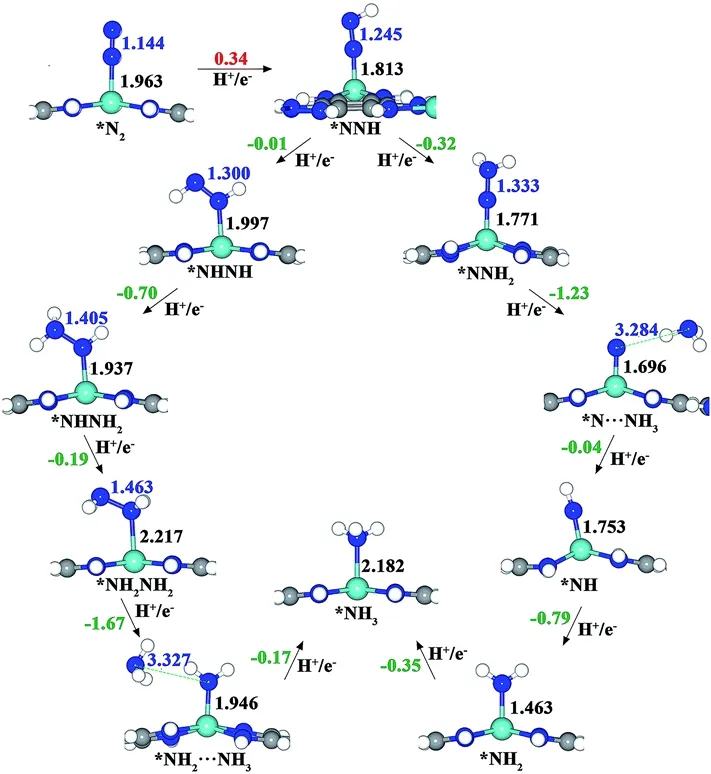
Fig. 8 The mechanisms of the NRR (distal, right; alternating, left).
Caoet al.employed the ultrasmall Fe(Ni)-MOF cluster with a size of 2–5 nm decorated on Ni(Fe)-MOF nanosheets on NiFe alloy foam (NFF) for the OER, which achieved a current density of 10 mA·cm−2within 227 mV and showed a small chargetransfer resistance of 1.54 Ω (Fig. 10a,b)116. The electron transfer between Ni2+and Fe3+in NiFe-NFF modulated the electronic environment of the Ni centers, thus enhancing the coupling effect between Ni and Fe active sites. The features of the unique nanostructure, the coupling effect, and higher intrinsic activity make the OER performance of catalysts better than that of the benchmark of RuO2. Besides, the better interface contact between substrate and electrocatalyst contributes to the improvement of the OER performance. Subsequently, the same group vertically inlaid ultrathin NiFe MOF nanosheets (1.5 nm)into a 3D ordered macroporous structure of NiFe hydroxide(OM-NFH) byin situgrowth method for enhancing the OER performance (Fig. 10c)117. Attributing to the efficient mass conduction between ordered macroporous hydroxide and nanosheets, effective electron transfer across hybrid material,and the highly exposed active centers, the electrocatalyst with high conductivity (Fig. 10d) exhibited an excellent catalytic activity with a current density of 10 mA·cm−2at 270 mV and long-term stability up to 10 h, much better than that of RuO2. In the same year, Zhenget al.synthesized several Fe/Ni bimetallic MOFs by solvothermal approach for improving OER performance, which can achieve a current density of 50 mA·cm–2at 270 mV118.
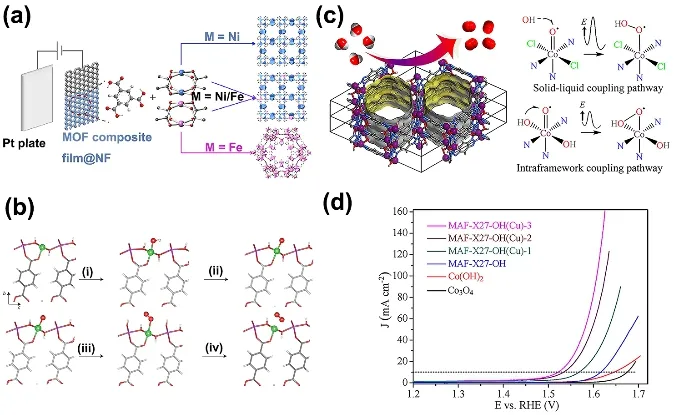
Fig. 9 (a) The scheme of Ni/Fe bimetallic MOF; (b) DFT calculation(NiCo-UMOFNs), (Ni/Co, green; Ni/Co, purple; O, red; C, grey;H, white); (c) 3D Structure of MAF-X27-OH; (d) LSV curves of different simples.

Fig. 10 (a) Scheme of synthesis of the NiFe-NFF electrode; (b) electrochemical impedance curves (EIS) conducted in O2-saturated 1.0 mol·L−1 KOH solution at 270 mV; (c) The fabrication of NiFe MOF/OM-NFH; (d) EIS test in O2-saturated 1.0 mol·L−1 KOH solution.
4 The challenges and opportunities for conductive MOFs
To date, various MOF-based catalysts have been fabricated and widely applied in catalysis as shown in Table 1. Particularly,the conductive MOF-based materials have exhibited significantly improved performance in different energy conversion reactions. Therefore, the development of novel MOFs with high conductivity is highly desired, yet remains a great challenge.
(1) Conductivity
Due to the inherent property of organic ligands, the conductivity of pristine MOFs is limited, which may become the dominant factor in restricting the advance of MOFs with high electroactivity. Choosing a proper strategy, such as fabricating continuous metal-ligand chains by coordination bonds,improving theπ–πstacking interactions of organic components,or integrating guest molecular in the inherent porosity forimproving the ability of the transfer of electrons and charge for MOF is crucial. Besides, anchoring the MOF films on the surface of the conductive substrates is demonstrated to be an effective approach as well.

Table 1 The performance of conductive MOFs for different energy conversion reactions.
(2) Catalytic activity
The existing catalytic reaction system faces a series of problems, such as high overpotential, low conversion efficiency,and unsatisfactory product selectivity. Adjusting the adsorption of intermediates on the active sitesviatuning metal nodes or organic ligands to decrease the free energy of adsorption and desorption and maximizing the utilization of active sitesviaintroducing co-catalysts with highly dispersed single-metal atoms, can effectively improve the electrocatalytic performance.Appropriate design of morphology and size can increase the number of exposed active sites, and thus amplify the catalytic performance, such as higher FE and selectivity. Furthermore,interface properties between different components,electrocatalysts, and electrolytes are all relevant to catalytic activity.
(3) The selectivity
The selectivity is a crucial factor for the electrocatalytic reactions, such as ORR, CO2RR, and NRR. A high-performance electrocatalyst should not only exhibit prominent catalytic activity but also own an outstanding selectivity. For example, the conversion of CO2to multi-carbon products on conductive MOFs still suffers from a big challenge in selectivity. Tandem catalysis in CO2RR could favor the formation of multi-carbon products, such as ethanol and ethylene. Besides, the interdistance which is often ignored parameter is a key factor to control the intermediates’ diffusion and adsorption, contributing to improving the selectivity.
(4) The stability
Stability is an important factor in long-term operation. The changes in composition, morphology, and structure could elucidate stability trends119,120More importantly, similar to catalytic activity, stability can be enhanced by adjusting the metal centers or organic ligands. Besides, employing metal centers with high oxidation states may also achieve this aim.
(5) The reaction mechanism
The reaction mechanisms should also be investigated to assess the effect of various factors on kinetics to design and prepare high-performance catalysts. Inspiringly, by combining the theory of computer science and quantum chemistry with experiments, lots of opportunities would be provided to promote the evolution of high-performance MOFs, and it can also decrease the workload of researchers. To further investigate the reaction mechanism, more advancedin situcharacterization technologies, such asin situX-ray photoelectron spectroscopy,operando Raman spectra, inductively coupled plasma mass spectrometry, X-ray absorption near-edge structure spectroscopy, should be applied to detect electrochemical reaction or monitor the change of surface state and the transformation of atomic structure. For example, the detection of the active sites on catalysts is beneficial to find the mechanisms and optimize the structure of electrocatalysts. Moreover,developing a large-scale synthesis strategy is of significance to put conductive MOF into practice121.
5 Conclusions and perspectives
In summary, this review summarizes the recent progress of conductive MOFs materials for a variety of energy conversion reactions, such as CO2RR, NRR, HER, ORR, and OER.Benefiting from their unique and intriguing physical and chemical properties of crystallinity, large surface area, high porosity, ordered porous structure, the abundant and ultrahigh density of catalytic active sites, and the combination of the merits of both heterogeneous and homogeneous electrocatalysts,conductive MOFs (powders, single crystals, or thin films) have been investigated for numerous applications, especially for electrocatalytic applications. Besides, various synthetic strategies (hydro/solvothermal synthesis and interface-assisted synthesis) have been demonstrated to prepare conductive MOFs with good charge-carrier mobility, controllable morphology, and tailorable structures.
Various strategies have been developed to fabricate conductive MOFs to improve pathways for charge transport and increase of mobile charge carriers, and the morphology control,component manipulation, and structural engineering, some potential directions are listed as follows: (i) Synthesizing large size of conductive MOFs single crystals is highly desirable. The single crystals of high-quality MOFs can not only avoid the loss of conductivity and improve intrinsic charge ability but also favor the studies of structure-property relationships. (ii)Preparing highly crystalline conductive MOFs thin films with few defects is essential for enhancing charge transport and broadening their electrical-related applications. (iii) it is imperative to develop a novel synthetic methodology for increasing the number of catalytic sites within the frameworks,thus improving their catalytic performances. (iv) The fabrication of heterostructured MOFs-covalent organic frameworks (COFs)or MOFs-MOFs may provide more opportunities for designing highly efficient MOFs-based electrocatalysts for different energy conversion reactions. For example, the composite containing intrinsic mixed valence of metals can promote the conductivity, compared to single species. Compared with amorphous materials, MOF-based materials are more structurally characterizable due to their crystallinity. The tolerability and tunability of molecular structure resulting from tuning metal node and organic ligand, make it possible to design and acquire desired materials with specific structures and corresponding functions. Therefore, more advanced and powerfulin situcharacterization techniques should be adapted to enclose the catalytic mechanism of active sites, thereby affording guidance to obtain MOFs-based electrocatalysts with improved catalytic performances (activity and selectivity) and enhanced stabilities. It is believed that all of these could endow MOFs materials with promising potential in the electrocatalytic applications.
